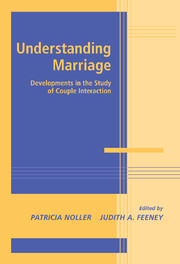Book contents
- Frontmatter
- Contents
- Contribitors
- Introduction
- SECTION ONE THE EFFECT OF COGNITION ON INTERACTION PATTERNS
- Introduction to Section One
- 1 Thought and Action: Connecting Attributions to Behaviors in Married Couples' Interactions
- 2 Self-Evaluation Motives in Close Relationships: A Model of Global Enhancement and Specific Verification
- 3 Competition in Romantic Relationships: Do Partners Build Niches?
- 4 Cognition and Communication during Marital Conflict: How Alcohol Affects Subjective Coding of Interaction in Aggressive and Nonaggressive Couples
- SECTION TWO UNDERSTANDING THE IMPORTANCE OF POSITIVE INTERACTION
- SECTION THREE COPING WITH DISAPPOINTMENT, CRITICISM, AND BETRAYAL
- SECTION FOUR POWER, CONFLICT, AND VIOLENCE IN MARITAL INTERACTION
- Marital interaction at important transition periods
- SECTION SIX Interventions for strengthening relationships
- Conclusions
- Index
- References
2 - Self-Evaluation Motives in Close Relationships: A Model of Global Enhancement and Specific Verification
Published online by Cambridge University Press: 25 July 2009
- Frontmatter
- Contents
- Contribitors
- Introduction
- SECTION ONE THE EFFECT OF COGNITION ON INTERACTION PATTERNS
- Introduction to Section One
- 1 Thought and Action: Connecting Attributions to Behaviors in Married Couples' Interactions
- 2 Self-Evaluation Motives in Close Relationships: A Model of Global Enhancement and Specific Verification
- 3 Competition in Romantic Relationships: Do Partners Build Niches?
- 4 Cognition and Communication during Marital Conflict: How Alcohol Affects Subjective Coding of Interaction in Aggressive and Nonaggressive Couples
- SECTION TWO UNDERSTANDING THE IMPORTANCE OF POSITIVE INTERACTION
- SECTION THREE COPING WITH DISAPPOINTMENT, CRITICISM, AND BETRAYAL
- SECTION FOUR POWER, CONFLICT, AND VIOLENCE IN MARITAL INTERACTION
- Marital interaction at important transition periods
- SECTION SIX Interventions for strengthening relationships
- Conclusions
- Index
- References
Summary
In their classic work on marriage, Berger and Kellner wrote: “The reality of the world is sustained through conversation with significant others” (1964, p. 53). Spouses, in particular, are said to provide each other with the most important source of feedback about the nature of the social world. More notably, spouses provide each other with the most important source of feedback about themselves (Berger & Kellner, 1964). Marriage involves an identity negotiation process in which spouses must determine the roles and characteristics each will assume within the relationship (for example, Schlenker, 1984). Marital satisfaction, then, may rest on whether spouses accept the identities each will hold in the marriage, and thus view and treat the other in the desired manner (Schlenker, 1984; Swann, 1984).
In fact, abundant evidence suggests that the feedback spouses provide one another concerning their identity within the relationship is associated with marital well-being. How intimates view one another has been linked to both the satisfaction and the stability of a relationship (for example, Murray, Holmes, & Griffin, 1996a; 1996b; Swann, De La Ronde, & Hixon, 1994). Nevertheless, researchers disagree on the type of feedback that is associated with positive relationship outcomes. Do spouses in satisfying relationships provide each other with favorable feedback, casting even negative qualities in a more positive light? Or do these spouses convey an accurate understanding of each other's qualities, acknowledging both strengths and weaknesses?
Information
- Type
- Chapter
- Information
- Understanding MarriageDevelopments in the Study of Couple Interaction, pp. 32 - 58Publisher: Cambridge University PressPrint publication year: 2002
References
Accessibility standard: Unknown
Why this information is here
This section outlines the accessibility features of this content - including support for screen readers, full keyboard navigation and high-contrast display options. This may not be relevant for you.Accessibility Information
- 6
- Cited by
